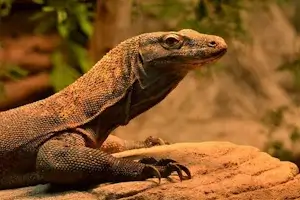The Care of Monitors: A Comprehensive Guide for Reptile Enthusiasts
Monitors are among the most fascinating reptiles that can be kept in terrariums. With their impressive size, intelligent behavior, and striking appearance, they are a highlight for experienced reptile keepers. However, caring for these exotic lizards requires a high level of expertise, dedication, and the willingness to invest time and resources. In this article, you’ll learn everything you need to know about caring for monitors, from choosing the right species to setting up the terrarium and providing proper care.
1. Why Keep a Monitor?
Monitors are not ordinary pets. They impress with:
- Intelligence: Monitors exhibit complex behaviors and can learn to recognize their owner.
- Unique Appearance: Their size and majestic presence make them a real eye-catcher.
- Challenge: Caring for monitors is demanding and ideal for experienced reptile keepers.
2. Choosing the Right Monitor Species
There are over 80 species of monitors worldwide, varying greatly in size, habitat, and behavior. For terrarium care, smaller to medium-sized species are particularly suitable:
Ackerman Monitor (Varanus acanthurus)
- Size: Up to 70 cm
- Origin: Australia
- Habitat: Deserts and savannas
- Special Features: Relatively easy to care for, ideal for advanced keepers
Emerald Monitor (Varanus prasinus)
- Size: Up to 1 meter
- Origin: New Guinea
- Habitat: Tropical rainforests
- Special Features: Arboreal, requires plenty of climbing space
Steppe Monitor (Varanus exanthematicus)
- Size: 1–1.2 meters
- Origin: Africa
- Habitat: Savannas and semi-deserts
- Special Features: Hardy, but needs a lot of space
For beginners, Ackerman monitors or smaller steppe monitors are better choices, as larger species like the Nile monitor or Komodo dragon have significant space and safety requirements.
3. The Terrarium for Monitors
Setting up the terrarium is crucial for the well-being of a monitor.
Terrarium Size
Monitors need a lot of space. The terrarium should be at least 2–3 times the length of the monitor’s body and 1.5 times as wide and high. For a 1-meter-long monitor, a minimum of 200 x 100 x 150 cm is required.
Equipment
- Substrate: Sand-clay mix for burrowing species, soil or bark for tropical species.
- Hiding Spots: Large caves, roots, or rocks.
- Climbing Space: Branches and platforms, especially for arboreal species.
- Water Source: Large enough for the monitor to bathe in.
Climate
- Temperature: Daytime 28–35°C, basking areas up to 45°C, nighttime 20–25°C.
- Humidity: Desert species 30–50%, tropical species 60–80%.
- Lighting: High-quality UVB lamps are essential to support calcium metabolism.
4. Monitor Nutrition
Monitors are carnivores that require a varied diet.
Food Sources
- Live Food: Insects like crickets, grasshoppers, or cockroaches.
- Frozen Food: Mice, rats, or chicks.
- Eggs: Chicken or quail eggs as occasional supplements.
- Fish: Fresh or frozen fish for aquatic species.
Feeding Frequency
- Juveniles: Every 1–2 days
- Adults: 1–2 times per week
Important Notes
- Don’t overfeed your monitor, as this can lead to obesity.
- Supplement the food with calcium and vitamin supplements, especially for juveniles.
5. Care and Health Monitoring
Regular Cleaning
- Remove feces and urine daily.
- Clean the entire terrarium thoroughly every month.
Shedding
Monitors shed regularly. Support the process by providing adequate humidity and rough surfaces in the terrarium.
Health Symptoms to Watch
- Healthy Monitors: Clear eyes, smooth skin, active behavior.
- Warning Signs: Lethargy, refusal to eat, breathing problems, or swollen limbs.
6. Behavior and Handling of Monitors
Monitors are intelligent animals that can develop trust in their owner with regular interaction.
Tips for Handling:
- Handle your monitor gently and only when it’s calm.
- Pick it up from the bottom, not from above, to avoid stress.
- Avoid sudden movements and loud noises.
7. Legal Requirements and Responsibility
Laws and Regulations
In many countries, the keeping of monitors is regulated. Make sure to inform yourself about:
- Conservation Laws (CITES)
- Reporting Obligations
- Proof of Origin of the Animal
Long-Term Responsibility
Monitors can live over 20 years, depending on the species. Ensure that you can provide the time, space, and financial resources for long-term care.
8. Common Mistakes in Monitor Care
- Terrarium Too Small: A cramped environment leads to stress and health problems.
- Incorrect Climate: Insufficient temperatures or humidity can cause respiratory diseases and other issues.
- Improper Diet: A monotonous or excessive diet can lead to deficiencies or obesity.
- Inappropriate Handling: Rough handling can cause injuries and stress.
9. Conclusion: The Rewarding Challenge of Keeping Monitors
Caring for monitors is challenging, but it offers a unique opportunity to experience these impressive animals up close. With the right preparation, a suitable living environment, and a species-appropriate diet, you can provide your monitor with a healthy and fulfilling life. Make sure to research thoroughly before selecting a monitor as a pet, and be aware of the long-term responsibility involved.

